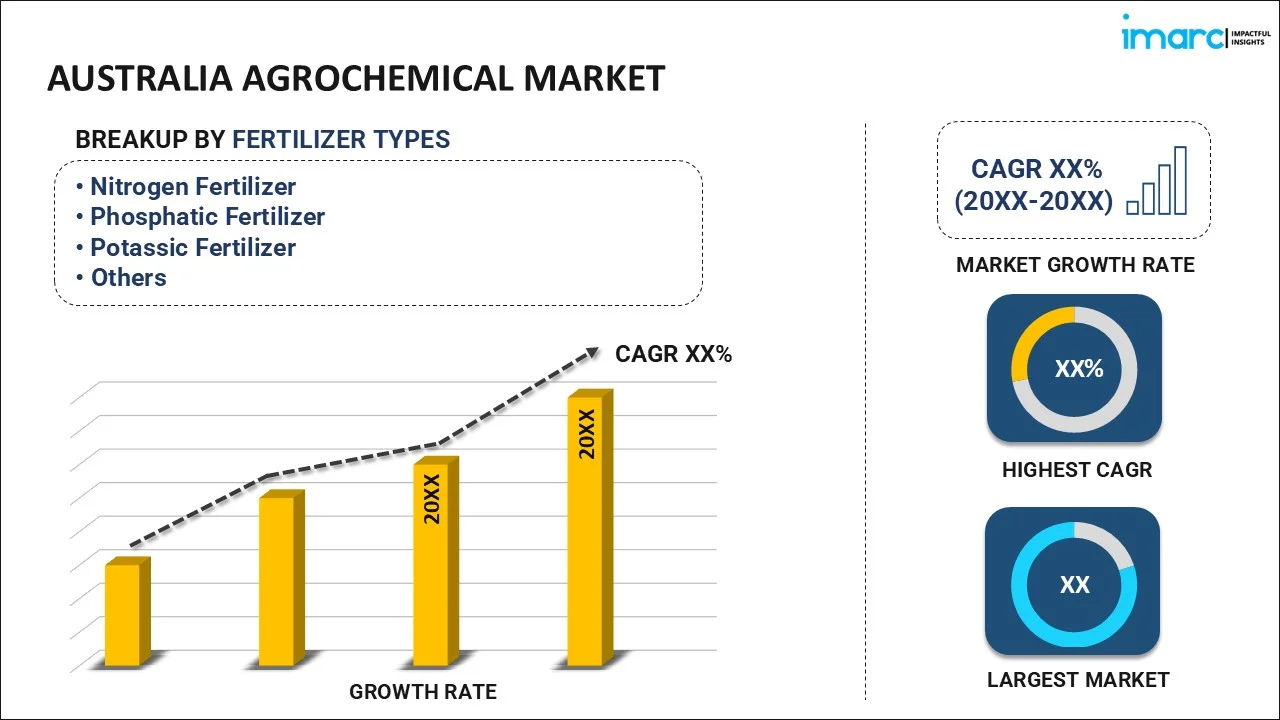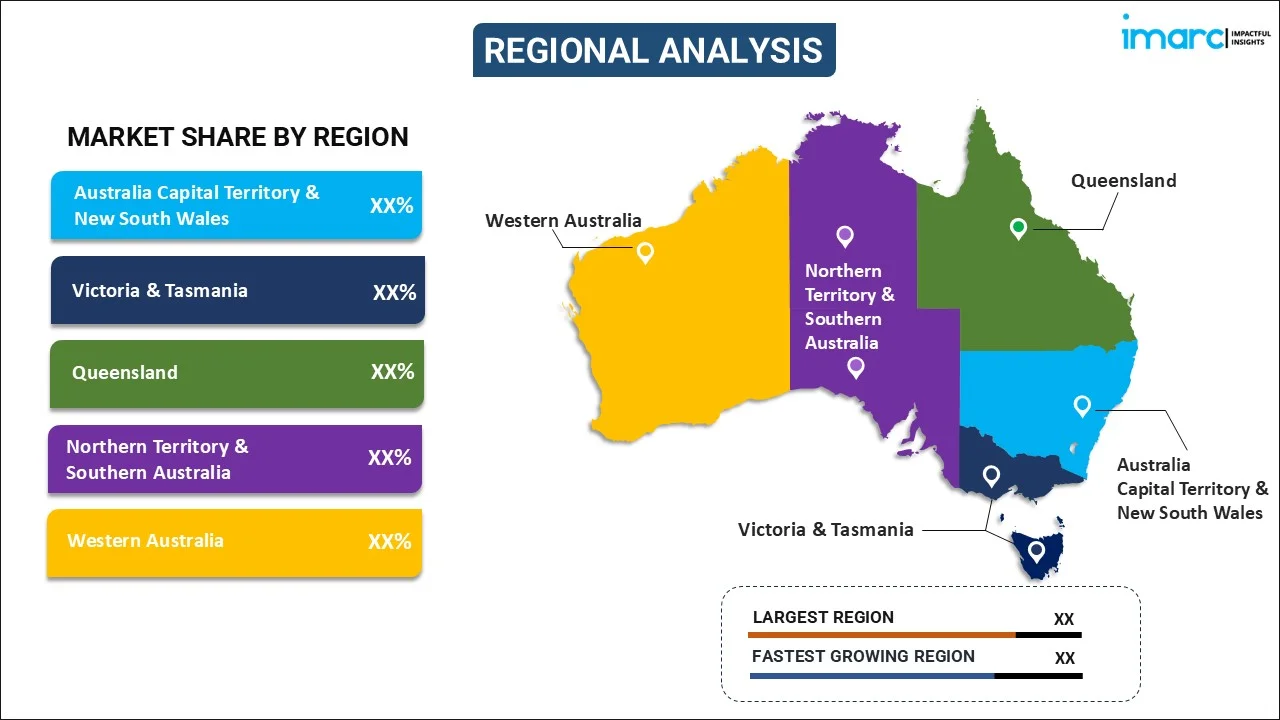
Australia Agrochemical Market Size, Share, Trends and Forecast by Fertilizer Type, Pesticide Type, Crop Type, and Region, 2025-2033
Australia Agrochemical Market Overview:
The Australia agrochemical market size reached USD 5,954.00 Million in 2024. Looking forward, IMARC Group expects the market to reach USD 7,974.65 Million by 2033, exhibiting a growth rate (CAGR) of 3.30% during 2025-2033. The increasing agrochemicals demand for crop protection solutions, growing need for higher agricultural productivity and sustainability, advanced formulation technologies, government support for agricultural innovations, and rising export opportunities for Australian produce are some of the factors positively impacting the Australia agrochemical market share.
|
Report Attribute
|
Key Statistics
|
|---|---|
|
Base Year
|
2024 |
|
Forecast Years
|
2025-2033
|
|
Historical Years
|
2019-2024
|
| Market Size in 2024 | USD 5,954.00 Million |
| Market Forecast in 2033 | USD 7,974.65 Million |
| Market Growth Rate (2025-2033) | 3.30% |
Australia Agrochemical Market Trends:
Shift Toward Biopesticides and Sustainable Agrochemicals
As global awareness of environmental sustainability rises, there is a noticeable shift toward biopesticides and eco-friendly agrochemicals, which is positively influencing the Australia agrochemicals market outlook. Biopesticides, derived from natural materials like plants, microorganisms, and minerals, offer a safer alternative to traditional chemical pesticides. The implementation of government policies and initiatives are making the landscapes and ecosystems less harmful and helps to maintain the health of soils. For example, on February 7, 2025, Australia was allocated USD 13 Million to enhance access to agricultural chemicals and veterinary chemicals. Such an effort aims to increase the availability of critical chemicals for enhancing productivity and sustainable agriculture. The developing regulatory frameworks and innovation in chemicals for agricultural sectors contributes to market expansion. Growing consumer demand and preference for chemical-free food also drive this trend. The rise of biological crop protection agents is supported by advances in biotechnology, which is making these products more effective and cost competitive. The agriculture sector seeks to meet both local and export market demands with stringent environmental regulations, thereby biopesticides are seen as key to achieving sustainable farming practices while maintaining productivity levels.
Circular Economy Adoption in Agrochemical Production
The growing emphasis on circular economy principles accelerate changes in the way chemicals are produced, used, and disposed of. In agrochemicals, this translates into efforts to reduce the environmental footprint of production processes, as well as to enhance the lifecycle of products used in farming. According to industry reports, the Australian government launched the National Circular Economy Framework (NCEF) to double the nation's circularity by 2035. The framework sets objectives toward reducing material consumption by 10% alongside increasing material productivity by 30% and recovering resources by 80%. It focuses on key sectors like industry, built environment, food, and agriculture, with economic projections showing an annual GDP boost of USD 26 Billion and a 14% reduction in greenhouse gas emissions. Therefore, Australian agrochemical companies are increasingly adopting practices such as using renewable raw materials for pesticide and fertilizer formulations, as well as developing bio-based alternatives to synthetic chemicals. Also, manufacturers are exploring ways to recycle and repurpose agricultural waste products, like crop residues, into inputs for agrochemical production. These initiatives support both the increasing consumer demand for sustainable agriculture methods and regulatory obligations, which is contributing to Australia agrochemical market growth.
Australia Agrochemical Market Segmentation:
IMARC Group provides an analysis of the key trends in each segment of the market, along with forecasts at the regional level for 2025-2033. Our report has categorized the market based on fertilizer type, pesticide type, and crop type.
Fertilizer Type Insights:

- Nitrogen Fertilizer
- Phosphatic Fertilizer
- Potassic Fertilizer
- Others
The report has provided a detailed breakup and analysis of the market based on the type. This includes nitrogen fertilizer, phosphatic fertilizer, potassic fertilizer, and others.
Pesticide Type Insights:
- Fungicides
- Herbicides
- Insecticides
- Others
A detailed breakup and analysis of the market based on the pesticide type have also been provided in the report. This includes fungicides, herbicides, insecticides, and others.
Crop Type Insights:
- Cereals and Grains
- Oilseeds and Pulses
- Fruits and Vegetables
- Others
The report has provided a detailed breakup and analysis of the market based on the crop type. This includes cereals and grains, oilseeds and pulses, fruits and vegetables, and others.
Regional Insights:

- Australia Capital Territory & New South Wales
- Victoria & Tasmania
- Queensland
- Northern Territory & Southern Australia
- Western Australia
The report has also provided a comprehensive analysis of all the major regional markets, which include Australia Capital Territory & News South Wales, Victoria & Tasmania, Queensland, Northern Territory & Southern Australia, and Western Australia.
Competitive Landscape:
The market research report has also provided a comprehensive analysis of the competitive landscape. Competitive analysis such as market structure, key player positioning, top winning strategies, competitive dashboard, and company evaluation quadrant has been covered in the report. Also, detailed profiles of all major companies have been provided.
Australia Agrochemical Market News:
- May 28, 2024: BASF introduced the Cimegra® insecticide in Australia. It is intended to provide crops, especially Brassica vegetables, with efficient protection. With a unique mode of action and no known resistance problems, the product, which is powered by a new active component, offers quick and durable control of pests like the Diamondback moth. With this introduction, BASF strengthens its position in the market and helps farmers in Australia manage insect resistance by using integrated pest management.
- September 23, 2024: Albaugh launched its new fungicide, Spiromax, in the Australian market. By shielding crops from a variety of fungal infections, the product is intended to increase crop quality and yield. Spiromax is a component of Albaugh's plan to diversify its business and provide Australian farmers with cutting-edge solutions.
Australia Agrochemical Market Report Coverage:
| Report Features | Details |
|---|---|
| Base Year of the Analysis | 2024 |
| Historical Period | 2019-2024 |
| Forecast Period | 2025-2033 |
| Units | Million USD |
| Scope of the Report |
Exploration of Historical Trends and Market Outlook, Industry Catalysts and Challenges, Segment-Wise Historical and Future Market Assessment:
|
| Types Covered | Nitrogen Fertilizer, Phosphatic Fertilizer, Potassic Fertilizer, Others |
| Pesticide Types Covered | Fungicides, Herbicides, Insecticides, Others |
| Crop Types Covered | Cereals and Grains, Oilseeds and Pulses, Fruits and Vegetables, Others |
| Regions Covered | Australia Capital Territory & News South Wales, Victoria & Tasmania, Queensland, Northern Territory & Southern Australia, Western Australia. |
| Customization Scope | 10% Free Customization |
| Post-Sale Analyst Support | 10-12 Weeks |
| Delivery Format | PDF and Excel through Email (We can also provide the editable version of the report in PPT/Word format on special request) |
Key Questions Answered in This Report:
- How has the Australia agrochemical market performed so far and how will it perform in the coming years?
- What is the breakup of the Australia agrochemical market on the basis of fertilizer type?
- What is the breakup of the Australia agrochemical market on the basis of pesticide type?
- What is the breakup of the Australia agrochemical market on the basis of crop type?
- What is the breakup of the Australia agrochemical market on the basis of region?
- What are the various stages in the value chain of the Australia agrochemical market?
- What are the key driving factors and challenges in the Australia agrochemical market?
- What is the structure of the Australia agrochemical market and who are the key players?
- What is the degree of competition in the Australia agrochemical market?
Key Benefits for Stakeholders:
- IMARC’s industry report offers a comprehensive quantitative analysis of various market segments, historical and current market trends, market forecasts, and dynamics of the Australia agrochemical market from 2019-2033.
- The research report provides the latest information on the market drivers, challenges, and opportunities in the Australia agrochemical market.
- Porter's five forces analysis assist stakeholders in assessing the impact of new entrants, competitive rivalry, supplier power, buyer power, and the threat of substitution. It helps stakeholders to analyze the level of competition within the Australia agrochemical industry and its attractiveness.
- Competitive landscape allows stakeholders to understand their competitive environment and provides an insight into the current positions of key players in the market.
Need more help?
- Speak to our experienced analysts for insights on the current market scenarios.
- Include additional segments and countries to customize the report as per your requirement.
- Gain an unparalleled competitive advantage in your domain by understanding how to utilize the report and positively impacting your operations and revenue.
- For further assistance, please connect with our analysts.
 Inquire Before Buying
Inquire Before Buying
 Speak to an Analyst
Speak to an Analyst
 Request Brochure
Request Brochure
 Request Customization
Request Customization




.webp)




.webp)












